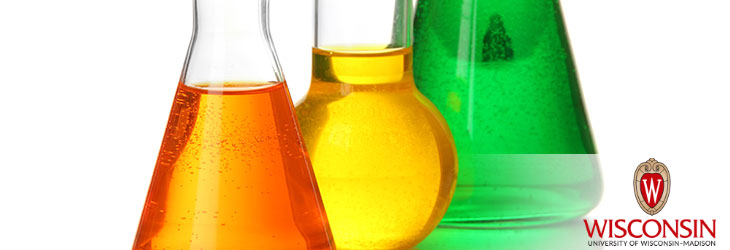Materials & Chemicals

New Conductive Polymers for Lithium Ion Batteries
WARF: P120049US02
Inventors: Mahesh Mahanthappa, Ryan Weber
The Wisconsin Alumni Research Foundation (WARF) is seeking commercial partners interested in developing novel metal bis(malonato)borate monomers and polymers particularly well-suited for use in lithium ion batteries.
Overview
Batteries can be classified as primary (nonreusable) or secondary (rechargeable). The demand for rechargeable batteries of high energy density and specific energy has surged along with portable electronics like cell phones and laptops.
Among commercially available types, lithium-ion batteries provide the highest energy densities. A modification of the lithium ion battery is the lithium-polymer battery, in which a polymer-gel electrolyte is used instead of a liquid electrolyte. This makes the batteries even more portable and safe because they require the use of smaller quantities of flammable solvents that are the major source of safety concerns with lithium-ion batteries.
One disadvantage, however, is that polymer-gel electrolytes exhibit transference numbers (i.e., the fraction of total current carried by a given ion) of about 20-40%, which results in the formation of electrical gradients in the battery that reduce its ultimate efficiency. Clearly, better polymers would lead to better batteries.
Among commercially available types, lithium-ion batteries provide the highest energy densities. A modification of the lithium ion battery is the lithium-polymer battery, in which a polymer-gel electrolyte is used instead of a liquid electrolyte. This makes the batteries even more portable and safe because they require the use of smaller quantities of flammable solvents that are the major source of safety concerns with lithium-ion batteries.
One disadvantage, however, is that polymer-gel electrolytes exhibit transference numbers (i.e., the fraction of total current carried by a given ion) of about 20-40%, which results in the formation of electrical gradients in the battery that reduce its ultimate efficiency. Clearly, better polymers would lead to better batteries.
The Invention
UW–Madison researchers have synthesized substituted metal bis(malonato)borate monomers, from which they have produced high molecular weight polymers via acyclic diene metathesis (ADMET) polymerization catalysis. When the metal is lithium, the polymers act as single ion conductors with high transference numbers favorable for battery usage. Previously, such conductors have been very difficult to synthesize.
Applications
- Development of new polymer-gel electrolytes, cathode binder materials and passivation layers
Key Benefits
- Provides new and improved lithium single ion conductors with stable functionalities
- Improves ion transference number
- Synthesis is straightforward and scalable.
- Relies on inexpensive, readily available materials
Additional Information
For More Information About the Inventors
Tech Fields
For current licensing status, please contact Jennifer Gottwald at [javascript protected email address] or 608-960-9854